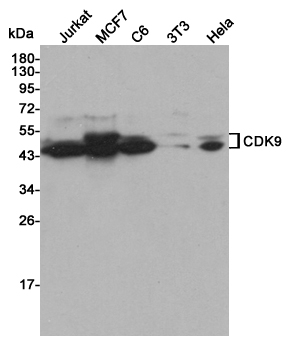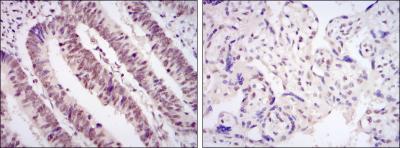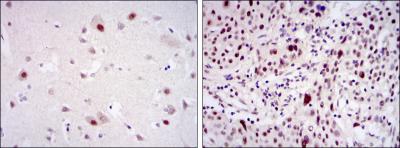-
Product Name
Anti-CDK9 (1C3) Mouse antibody
- Documents
-
Description
CDK9 (1C3) Mouse monoclonal antibody
-
Tested applications
WB, IHC-P
-
Species reactivity
Human
-
Isotype
Mouse IgG1
-
Preparation
Antigen: Purified recombinant fragment of human CDK9 expressed in E. Coli.
-
Clonality
Monoclonal
-
Formulation
Ascitic fluid containing 0.03% sodium azide.
-
Storage instructions
Store at 4°C short term. Store at -20°C long term. Avoid freeze / thaw cycle.
-
Applications
WB: 1/500 - 1/2000
IHC: 1/200 - 1/1000
ELISA: 1/10000
-
Validations

Western blot detection of CDK9 in Jurkat,MCF7,C6,3T3 and Hela cell lysates using CDK9 mouse mAb (1:2000 diluted).Predicted band size:43KDa.Observed band size:43,50KDa.

Immunohistochemical analysis of paraffin-embedded rectum cancer tissues (left) and placenta tissues (right) using CDK9 mouse mAb with DAB staining.

Immunohistochemical analysis of paraffin-embedded brain tissues (left) and esophageal cancer tissues (right) using CDK9 mouse mAb with DAB staining.
-
Background
Swiss-Prot Acc.P50750.The protein encoded by this gene is a member of the cyclin-dependent protein kinase (CDK) family. CDK family members are highly similar to the gene products of S. cerevisiae cdc28, and S. pombe cdc2, and known as important cell cycle regulators. This kinase was found to be a component of the multiprotein complex TAK/P-TEFb, which is an elongation factor for RNA polymerase II-directed transcription and functions by phosphorylating the C-terminal domain of the largest subunit of RNA polymerase II. This protein forms a complex with and is regulated by its regulatory subunit cyclin T or cyclin K. HIV-1 Tat protein was found to interact with this protein and cyclin T, which suggested a possible involvement of this protein in AIDS. (provided by RefSeq)Tissue specificity: Ubiquitous.
Related Products / Services
Please note: All products are "FOR RESEARCH USE ONLY AND ARE NOT INTENDED FOR DIAGNOSTIC OR THERAPEUTIC USE"
